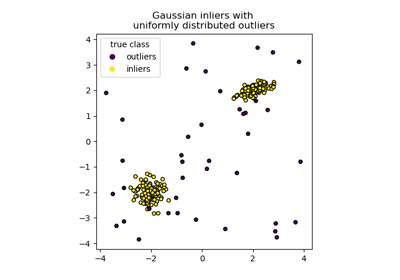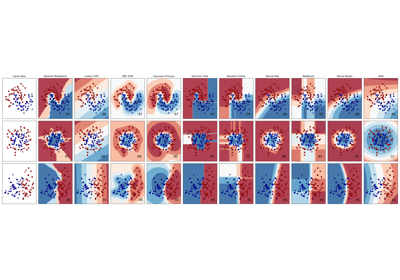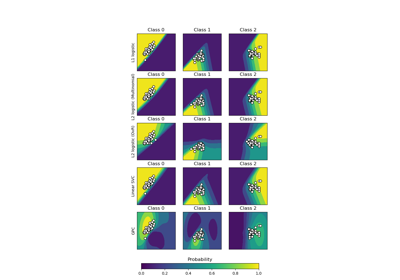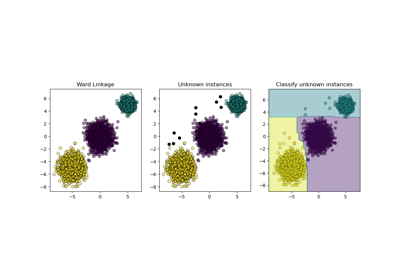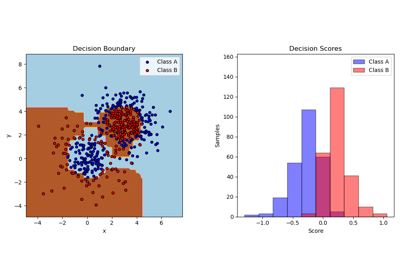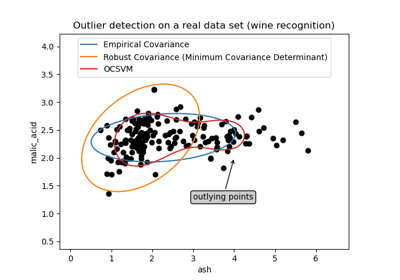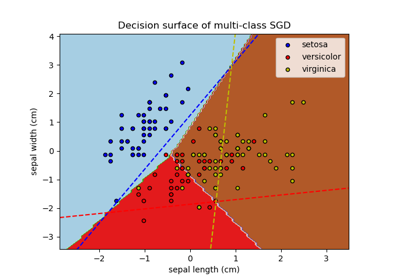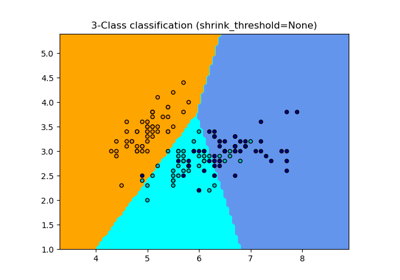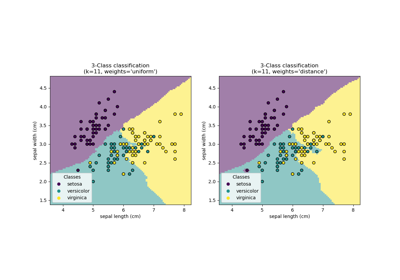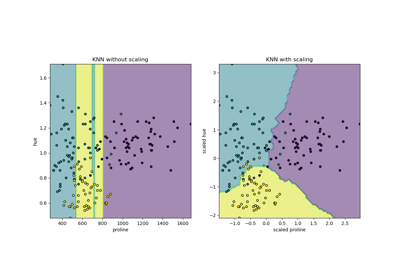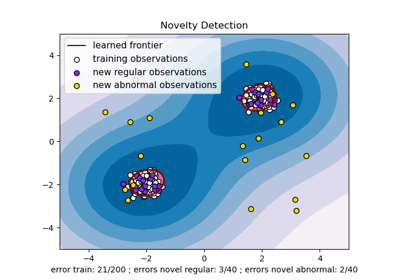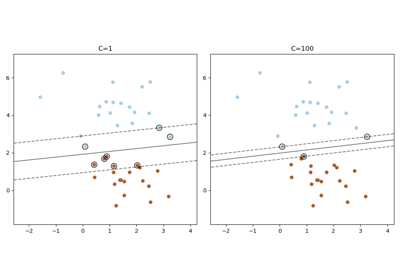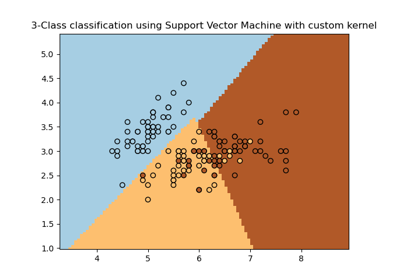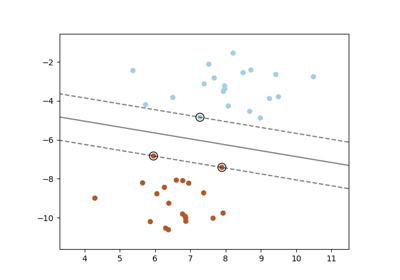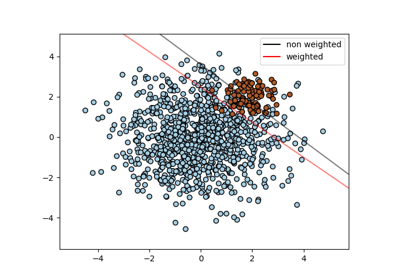DecisionBoundaryDisplay#
- class sklearn.inspection.DecisionBoundaryDisplay(*, xx0, xx1, response, xlabel=None, ylabel=None)[source]#
Decisions boundary visualization.
It is recommended to use
from_estimatorto create aDecisionBoundaryDisplay. All parameters are stored as attributes.Read more in the User Guide.
Added in version 1.1.
- Parameters:
- xx0ndarray of shape (grid_resolution, grid_resolution)
First output of
meshgrid.- xx1ndarray of shape (grid_resolution, grid_resolution)
Second output of
meshgrid.- responsendarray of shape (grid_resolution, grid_resolution)
Values of the response function.
- xlabelstr, default=None
Default label to place on x axis.
- ylabelstr, default=None
Default label to place on y axis.
- Attributes:
- surface_matplotlib
QuadContourSetorQuadMesh If
plot_methodis ‘contour’ or ‘contourf’,surface_is aQuadContourSet. Ifplot_methodis ‘pcolormesh’,surface_is aQuadMesh.- ax_matplotlib Axes
Axes with decision boundary.
- figure_matplotlib Figure
Figure containing the decision boundary.
- surface_matplotlib
See also
DecisionBoundaryDisplay.from_estimatorPlot decision boundary given an estimator.
Examples
>>> import matplotlib.pyplot as plt >>> import numpy as np >>> from sklearn.datasets import load_iris >>> from sklearn.inspection import DecisionBoundaryDisplay >>> from sklearn.tree import DecisionTreeClassifier >>> iris = load_iris() >>> feature_1, feature_2 = np.meshgrid( ... np.linspace(iris.data[:, 0].min(), iris.data[:, 0].max()), ... np.linspace(iris.data[:, 1].min(), iris.data[:, 1].max()) ... ) >>> grid = np.vstack([feature_1.ravel(), feature_2.ravel()]).T >>> tree = DecisionTreeClassifier().fit(iris.data[:, :2], iris.target) >>> y_pred = np.reshape(tree.predict(grid), feature_1.shape) >>> display = DecisionBoundaryDisplay( ... xx0=feature_1, xx1=feature_2, response=y_pred ... ) >>> display.plot() <...> >>> display.ax_.scatter( ... iris.data[:, 0], iris.data[:, 1], c=iris.target, edgecolor="black" ... ) <...> >>> plt.show()
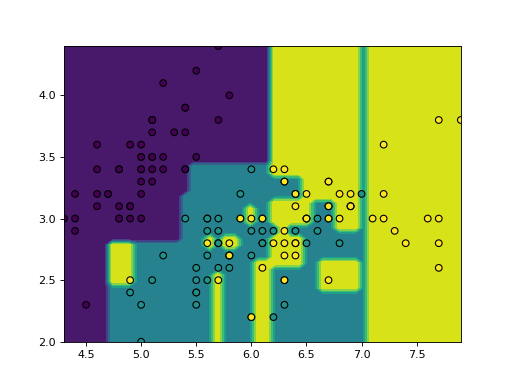
- classmethod from_estimator(estimator, X, *, grid_resolution=100, eps=1.0, plot_method='contourf', response_method='auto', class_of_interest=None, xlabel=None, ylabel=None, ax=None, **kwargs)[source]#
Plot decision boundary given an estimator.
Read more in the User Guide.
- Parameters:
- estimatorobject
Trained estimator used to plot the decision boundary.
- X{array-like, sparse matrix, dataframe} of shape (n_samples, 2)
Input data that should be only 2-dimensional.
- grid_resolutionint, default=100
Number of grid points to use for plotting decision boundary. Higher values will make the plot look nicer but be slower to render.
- epsfloat, default=1.0
Extends the minimum and maximum values of X for evaluating the response function.
- plot_method{‘contourf’, ‘contour’, ‘pcolormesh’}, default=’contourf’
Plotting method to call when plotting the response. Please refer to the following matplotlib documentation for details:
contourf,contour,pcolormesh.- response_method{‘auto’, ‘predict_proba’, ‘decision_function’, ‘predict’}, default=’auto’
Specifies whether to use predict_proba, decision_function, predict as the target response. If set to ‘auto’, the response method is tried in the following order: decision_function, predict_proba, predict. For multiclass problems, predict is selected when
response_method="auto".- class_of_interestint, float, bool or str, default=None
The class considered when plotting the decision. If None,
estimator.classes_[1]is considered as the positive class for binary classifiers. Must have an explicit value for multiclass classifiers whenresponse_methodis ‘predict_proba’ or ‘decision_function’.Added in version 1.4.
- xlabelstr, default=None
The label used for the x-axis. If
None, an attempt is made to extract a label fromXif it is a dataframe, otherwise an empty string is used.- ylabelstr, default=None
The label used for the y-axis. If
None, an attempt is made to extract a label fromXif it is a dataframe, otherwise an empty string is used.- axMatplotlib axes, default=None
Axes object to plot on. If
None, a new figure and axes is created.- **kwargsdict
Additional keyword arguments to be passed to the
plot_method.
- Returns:
- display
DecisionBoundaryDisplay Object that stores the result.
- display
See also
DecisionBoundaryDisplayDecision boundary visualization.
sklearn.metrics.ConfusionMatrixDisplay.from_estimatorPlot the confusion matrix given an estimator, the data, and the label.
sklearn.metrics.ConfusionMatrixDisplay.from_predictionsPlot the confusion matrix given the true and predicted labels.
Examples
>>> import matplotlib.pyplot as plt >>> from sklearn.datasets import load_iris >>> from sklearn.linear_model import LogisticRegression >>> from sklearn.inspection import DecisionBoundaryDisplay >>> iris = load_iris() >>> X = iris.data[:, :2] >>> classifier = LogisticRegression().fit(X, iris.target) >>> disp = DecisionBoundaryDisplay.from_estimator( ... classifier, X, response_method="predict", ... xlabel=iris.feature_names[0], ylabel=iris.feature_names[1], ... alpha=0.5, ... ) >>> disp.ax_.scatter(X[:, 0], X[:, 1], c=iris.target, edgecolor="k") <...> >>> plt.show()
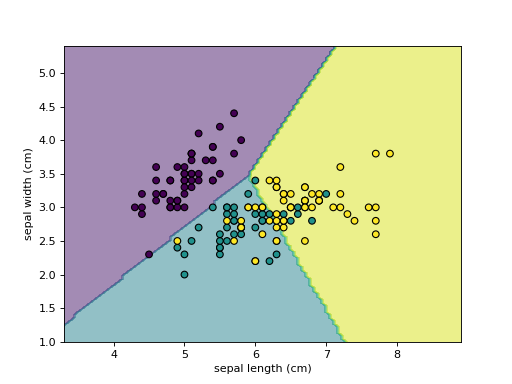
- plot(plot_method='contourf', ax=None, xlabel=None, ylabel=None, **kwargs)[source]#
Plot visualization.
- Parameters:
- plot_method{‘contourf’, ‘contour’, ‘pcolormesh’}, default=’contourf’
Plotting method to call when plotting the response. Please refer to the following matplotlib documentation for details:
contourf,contour,pcolormesh.- axMatplotlib axes, default=None
Axes object to plot on. If
None, a new figure and axes is created.- xlabelstr, default=None
Overwrite the x-axis label.
- ylabelstr, default=None
Overwrite the y-axis label.
- **kwargsdict
Additional keyword arguments to be passed to the
plot_method.
- Returns:
- display:
DecisionBoundaryDisplay Object that stores computed values.
- display:
Gallery examples#
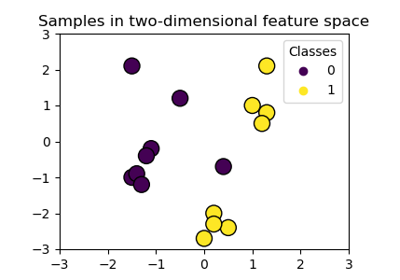
Plot classification boundaries with different SVM Kernels
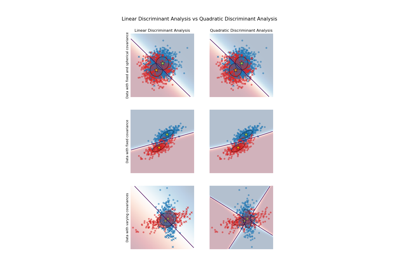
Linear and Quadratic Discriminant Analysis with covariance ellipsoid
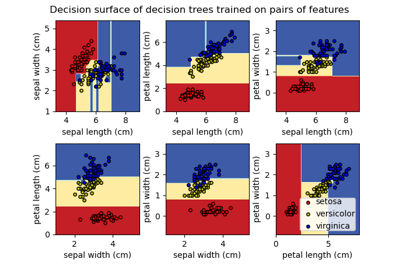
Plot the decision surface of decision trees trained on the iris dataset
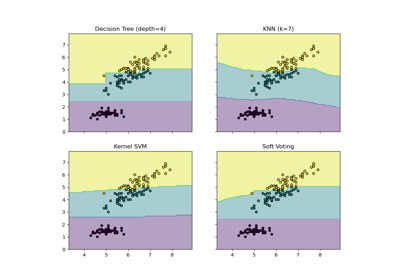
Plot the decision boundaries of a VotingClassifier
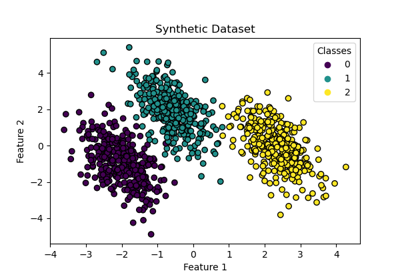
Decision Boundaries of Multinomial and One-vs-Rest Logistic Regression
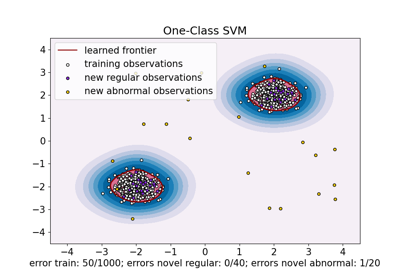
One-Class SVM versus One-Class SVM using Stochastic Gradient Descent
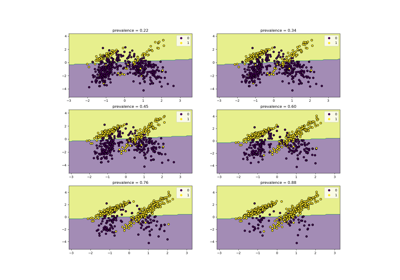
Class Likelihood Ratios to measure classification performance
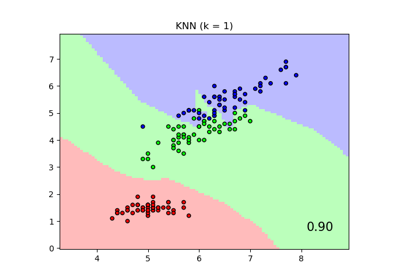
Comparing Nearest Neighbors with and without Neighborhood Components Analysis

Plot classification boundaries with different SVM Kernels
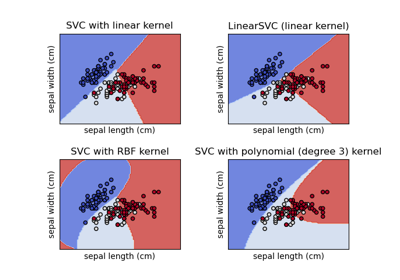
Plot different SVM classifiers in the iris dataset

